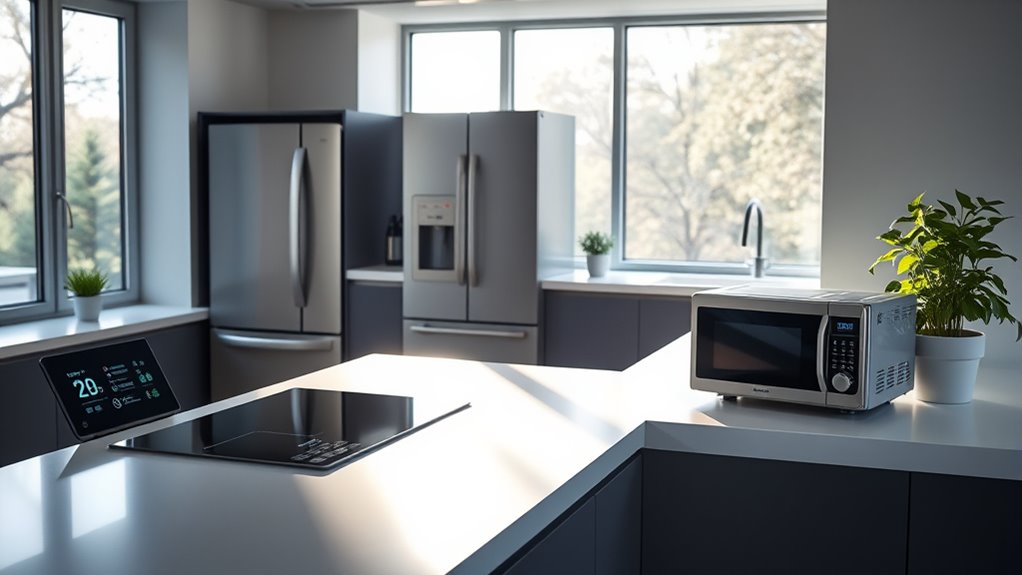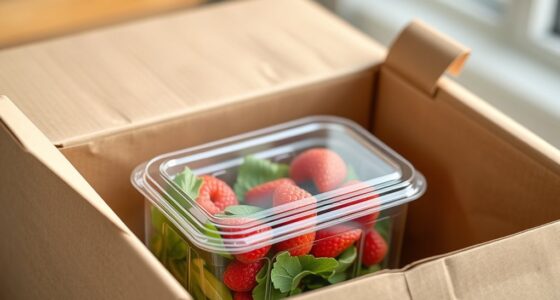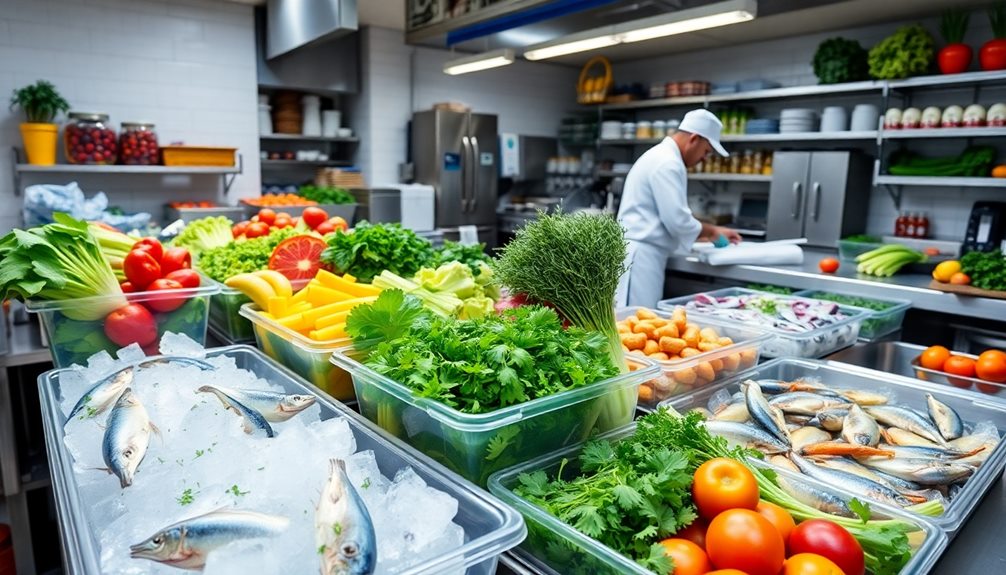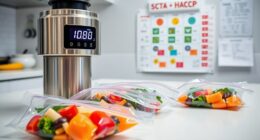To manage kitchen energy costs effectively, start by monitoring your energy use and choosing ENERGY STAR-rated appliances. Optimize cooking by using lids, matching cookware to burners, and planning meals wisely. Switch to LED lighting, maximize natural light, and turn off unused devices. Regular maintenance like cleaning filters and defrosting freezers helps appliances run efficiently. Incorporate smart technology to automate and track energy use. If you keep going, you’ll discover more practical ways to save and stay eco-friendly.
Key Takeaways
- Monitor and analyze energy usage regularly with smart meters or logs to identify high consumption patterns.
- Choose energy-efficient appliances, such as ENERGY STAR-rated models, and maintain them properly for optimal performance.
- Optimize cooking and lighting practices by using lids, matching cookware to burners, and switching to LED bulbs.
- Automate and control appliances with smart technology to reduce standby power and adjust energy use remotely.
- Implement sustainable design features like natural lighting, eco-friendly materials, and water-saving fixtures to lower overall energy costs.
Assessing Your Current Energy Usage
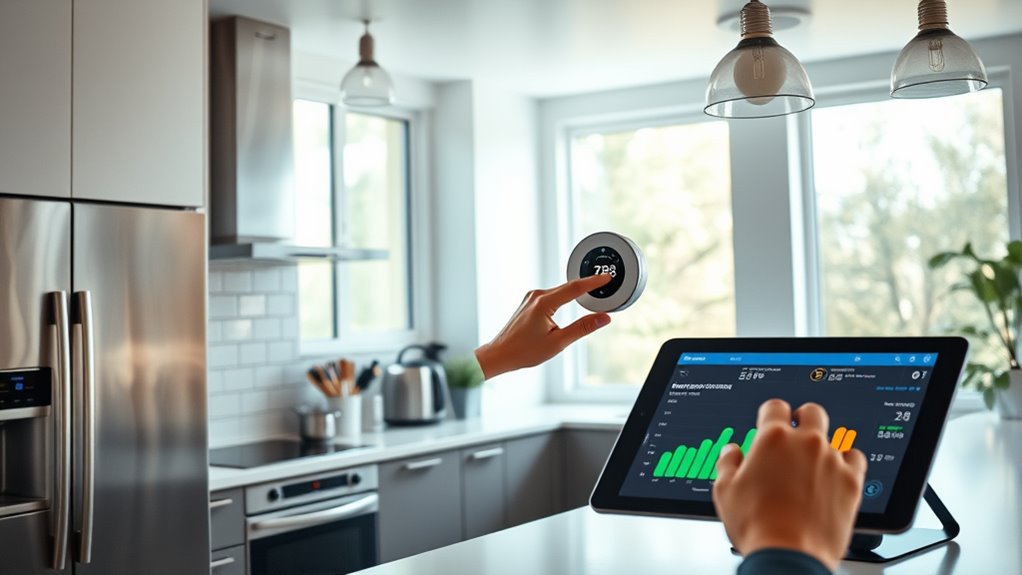
Before making any changes to reduce your energy costs, you need to understand how much energy your kitchen currently uses. Start by reviewing your utility bills to identify your average monthly and yearly energy consumption. Look for patterns—are there specific times when your energy use spikes? Consider installing a temporary energy monitor or smart meter to track usage in real-time. This will help you pinpoint which appliances or activities consume the most power. Keep a journal of your daily kitchen routines to see where energy is being wasted, such as leaving appliances on or inefficient cooking habits. Analyzing your energy patterns can also reveal the impact of Dad’s Life Lessons and how consistent habits influence overall energy efficiency. Accurate assessment helps you target the right areas for improvement, making your efforts more effective and cost-efficient.
Choosing Energy-Efficient Appliances
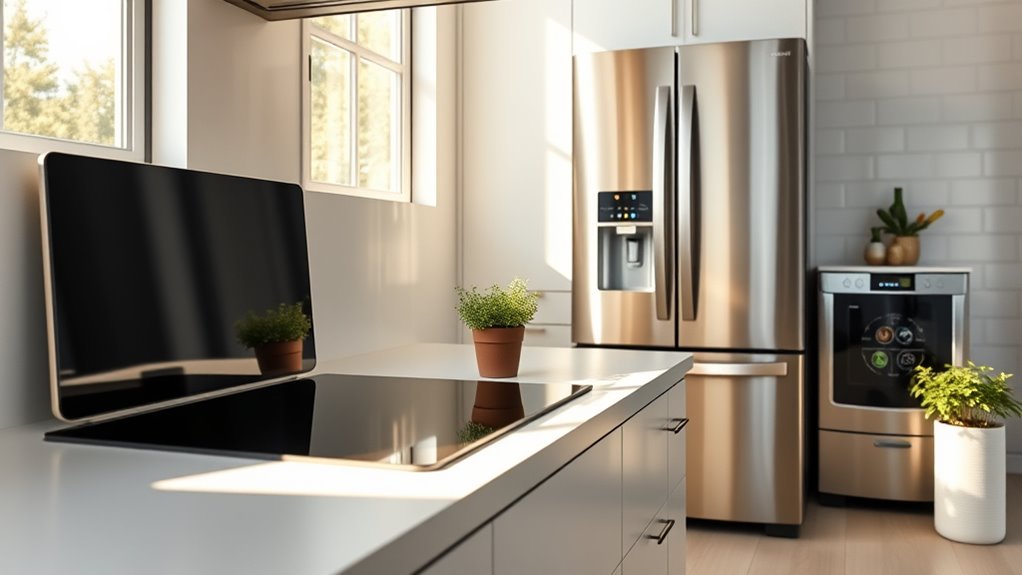
When selecting appliances, look for Energy Star ratings to guarantee they meet energy efficiency standards. Smart features can also help you monitor and reduce energy use effortlessly. Choosing appliances with these qualities can considerably cut your kitchen’s energy costs. Additionally, opting for devices that promote efficient energy use can enhance overall savings and environmental impact.
Energy Star Ratings
Choosing appliances with an Energy Star rating can considerably reduce your kitchen’s energy costs. These appliances meet strict energy efficiency standards set by the EPA, ensuring you get quality products that save energy and money. When shopping, look for the blue Energy Star label—it’s your quick guarantee of efficiency. Here are some benefits:
- Lower Utility Bills: Energy-efficient appliances consume less power, cutting your monthly expenses.
- Environmental Impact: Reduced energy use means fewer greenhouse gas emissions.
- Long-Term Savings: Although they may cost more upfront, Energy Star appliances save you money over time through lower operating costs.
In addition, incorporating sound design techniques like effective ambient sounds can enhance the overall appeal and user experience of your kitchen environment.
Smart Appliance Features
Smart appliance features can markedly enhance your kitchen’s energy efficiency by automatically adjusting operations to save power. For example, smart refrigerators detect when doors are left open and reduce cooling to prevent waste. Dishwashers with sensors optimize water and energy use based on load size, while smart ovens adjust cooking times and temperatures for efficiency. Many appliances learn your habits, turning off or entering low-power modes when not in use. Voice control and remote monitoring let you manage appliances efficiently, avoiding unnecessary energy consumption. These features not only cut costs but also help you minimize your environmental impact. When choosing appliances, prioritize those with smart features that promote energy savings, ensuring your kitchen stays efficient and eco-friendly. Incorporating energy-efficient technologies can further maximize your savings and reduce your carbon footprint.
Optimizing Cooking Practices

Using the right size cookware helps you save energy by reducing heat loss and cooking time. You can also cut costs by applying energy-efficient techniques like pressure cooking or using lids. Small adjustments in your cooking practices can make a big difference in your energy bills. Incorporating proper kitchen organization can further enhance efficiency and minimize unnecessary energy use.
Use Appropriate Cookware Size
To optimize energy efficiency in your kitchen, it’s essential to select cookware that matches the size of your stovetop burners and the amount of food you’re preparing. Using the right-sized pots and pans ensures heat transfers effectively, reducing wasted energy.
Here are three tips to help you choose appropriately:
- Match the diameter of your cookware to the burner size to prevent heat loss around the edges.
- Use smaller pots for cooking small portions to avoid heating excess space.
- When boiling water or simmering, opt for cookware that covers the burner completely for even heat distribution.
Maximize Energy-Efficient Techniques
Maximizing energy-efficient techniques in your kitchen involves adopting practical cooking habits that save both time and energy. Start by planning meals to reduce unnecessary cooking sessions. Use lids on pots and pans to trap heat and cook faster, conserving energy. Opt for pressure cookers or slow cookers—they use less energy than traditional methods. When boiling water, only fill the kettle with the amount you need, and cover pots to speed up boiling. Avoid opening the oven door frequently, as heat escapes and increases energy use. Use residual heat by turning off appliances a few minutes before the cooking time ends. Additionally, match cookware size to the burner to prevent heat loss. Being aware of juice detox side effects can help you make informed choices about your dietary habits. These habits collectively lower energy consumption and make your kitchen more efficient.
Managing Kitchen Lighting Effectively

Have you considered how your kitchen lighting impacts both energy use and your overall comfort? Proper management can make a big difference. Here are three tips to optimize your lighting:
- Use task lighting for specific areas like counters and stoves, instead of bright overhead lights all the time.
- Switch to LED bulbs—they consume less energy and last longer.
- Take advantage of natural light by opening curtains during the day, reducing the need for artificial lighting.
- Incorporating energy-efficient lighting can further reduce overall costs and environmental impact.
Using Smart Technology for Energy Control
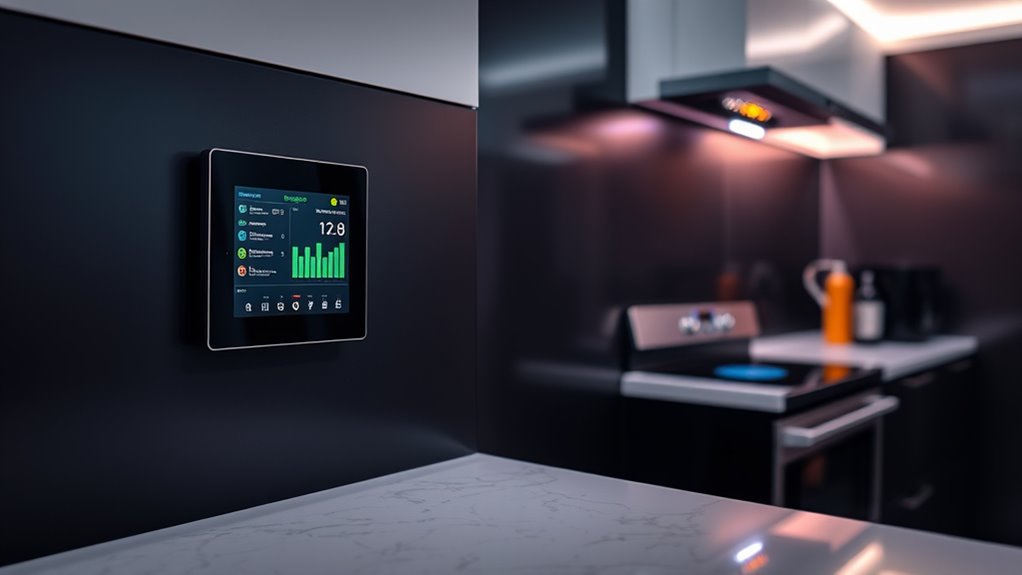
Smart technology offers an easy way to control your kitchen’s energy use more efficiently. With smart sensors and connected devices, you can automate lighting, appliances, and climate control to match your actual needs. For example, smart thermostats can adjust temperature based on occupancy, saving energy when you’re not around. Smart plugs allow you to turn off appliances remotely or set schedules, preventing standby power drain. Voice-activated assistants make it simple to manage devices without manual effort. Additionally, energy monitoring apps provide real-time data, so you can identify which appliances consume the most energy and adjust your habits accordingly. Using these technologies, you gain greater control over your energy use, reduce waste, and lower your bills—all while making your kitchen smarter and more sustainable. Trustworthy brands ensure these devices are reliable and safe to use.
Maintaining Appliances for Peak Performance

Regularly maintaining your kitchen appliances guarantees they operate efficiently and last longer. When you keep up with routine checks, you prevent energy waste and costly repairs. Here’s how to keep them in top shape:
Consistent appliance care ensures efficiency, longevity, and savings on energy and repairs.
- Clean filters and vents regularly to ensure proper airflow and prevent overheating.
- Defrost freezers when ice buildup exceeds a quarter-inch, which helps them run efficiently.
- Inspect and replace worn seals on refrigerators and ovens to prevent energy leaks.
- Applying skincare patches properly can prevent unnecessary irritation and ensure effective treatment.
Incorporating Sustainable Kitchen Design
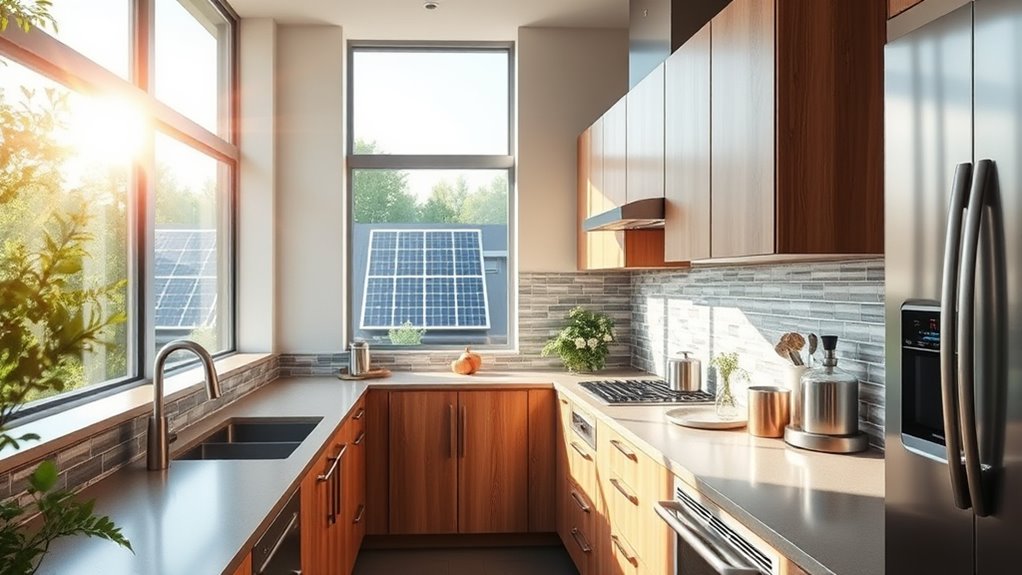
Incorporating sustainable kitchen design involves choosing eco-friendly materials, appliances, and layouts that reduce energy consumption. Opt for countertops made from recycled or sustainably sourced materials, and select appliances with high energy efficiency ratings. Layout matters too—design your kitchen for maximum natural light and airflow, reducing reliance on artificial lighting and climate control. Consider installing LED lighting and water-saving fixtures to further cut down on resource use. Additionally, understanding divorce statistics can help homeowners plan for future financial stability when making major renovations. Below is a table highlighting key sustainable choices:
| Eco-Friendly Materials | Efficient Appliances |
|---|---|
| Recycled countertops | ENERGY STAR-rated appliances |
| Bamboo flooring | Low-flow faucets |
| Reclaimed wood cabinets | Induction cooktops |
Practical Tips for Daily Energy Conservation
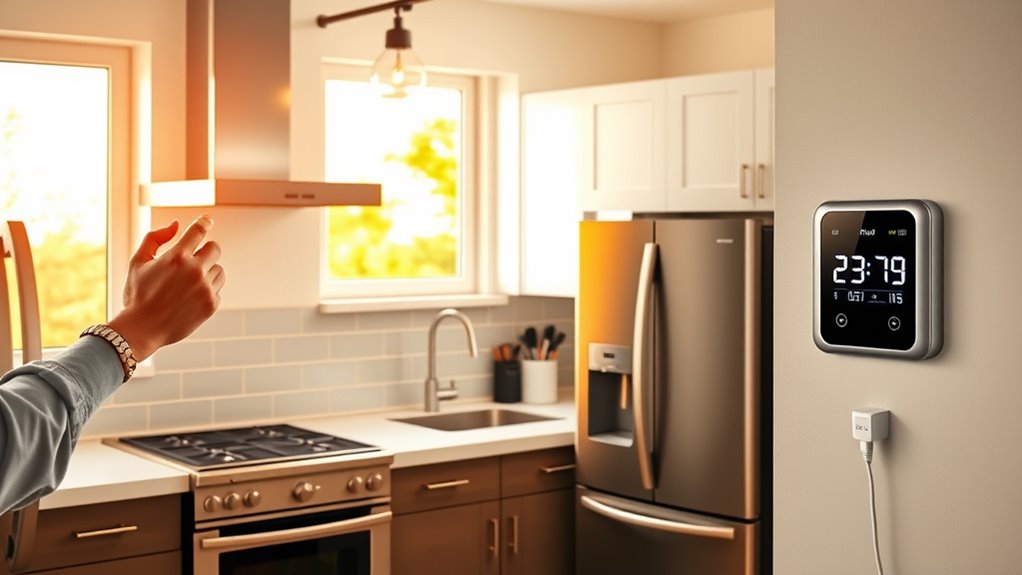
To save energy daily, start by being mindful of your lighting and appliance use. Small changes can lead to big savings. First, turn off lights when you leave a room to avoid unnecessary energy waste. Second, use energy-efficient bulbs like LEDs—they consume less power and last longer. Third, run your dishwasher and washing machine only with full loads and during off-peak hours if possible. Additionally, unplug appliances when you’re not using them to prevent phantom energy drain. Keep your fridge at the right temperature—not too cold—and defrost it regularly to ensure efficiency. Using lids while cooking and avoiding preheating the oven excessively also help reduce energy consumption. These simple habits make a noticeable difference in your kitchen’s energy costs.
Monitoring and Tracking Your Energy Expenses

Tracking your energy expenses allows you to identify where you can cut costs and improve efficiency. Start by reviewing your utility bills regularly to spot patterns and high-usage periods. Use energy monitoring tools or smart meters to get real-time data on your appliances’ consumption. Keep a journal or digital log to record daily energy use, noting activities that spike costs. This helps you pinpoint wasteful behaviors and appliances that need maintenance or replacement. Set monthly goals to reduce your energy expenses and track your progress. By staying aware of your energy habits, you can make informed decisions, such as adjusting usage times or upgrading equipment, ultimately saving money and extending your appliances’ lifespan. Consistent monitoring keeps you proactive and in control of your kitchen’s energy costs.
Frequently Asked Questions
What Are the Long-Term Financial Benefits of Energy-Efficient Kitchens?
You might wonder about the long-term financial benefits of energy-efficient kitchens. By investing in energy-saving appliances and smart systems, you reduce your utility bills over time. These upgrades also decrease maintenance costs and extend appliance lifespan. Additionally, you could enjoy tax incentives or rebates. Overall, energy-efficient kitchens help you save money now and in the future while supporting environmental sustainability.
How Can I Prioritize Energy Savings Without Sacrificing Kitchen Functionality?
You can prioritize energy savings by focusing on essential appliances and upgrading to energy-efficient models. Use smart controls to manage lighting and temperature, and schedule appliance use during off-peak hours. Keep your kitchen well-maintained to guarantee maximum performance. By balancing functionality with efficiency, you save energy without compromising on convenience, making your kitchen both practical and cost-effective in the long run.
Are There Any Government Incentives for Installing Energy-Efficient Kitchen Appliances?
You might wonder if government incentives help with installing energy-efficient kitchen appliances. Yes, many programs offer rebates, tax credits, or grants to encourage energy-saving upgrades. Check local, state, and federal websites for current offers, as they vary by location and appliance type. Taking advantage of these incentives can reduce your upfront costs, making it easier to upgrade without sacrificing kitchen functionality or breaking the bank.
How Do Different Cooking Methods Impact Overall Energy Consumption?
Different cooking methods markedly affect your energy use. For example, boiling on a stove consumes more energy than using a microwave, which heats food faster and more efficiently. Using pressure cookers or induction cooktops also reduces energy consumption compared to traditional electric or gas stoves. By choosing quicker, more efficient techniques, you can lower your overall energy costs and minimize environmental impact while preparing meals.
What Future Innovations Could Further Reduce Kitchen Energy Costs?
Imagine a world where your kitchen transforms into an energy-efficient haven. Future innovations like smart appliances, AI-powered cooking systems, and advanced insulation can slash your energy costs dramatically. You’ll enjoy faster, smarter cooking while minimizing waste. These breakthroughs act as a beacon guiding you toward sustainability, making your kitchen not just a place to cook, but a hub of eco-friendly technology that saves money and protects the planet.
Conclusion
By implementing these energy-cost management strategies, you can save money and reduce your environmental footprint. Are you ready to take control of your kitchen’s energy use and make a positive impact? Every small change adds up, and your efforts can lead to a more sustainable, cost-effective home. Don’t wait—start today and turn your kitchen into a model of efficiency and responsibility. The power to make a difference is in your hands.
